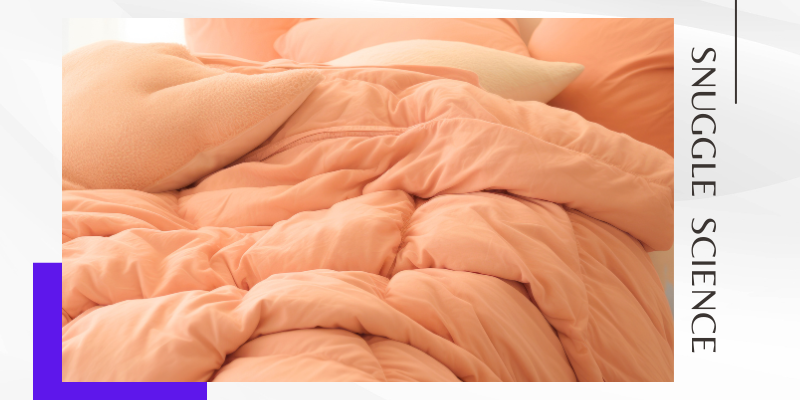
Duvets vs. Comforters: A Guide to Understanding Which One is Right for You.
It’s the choice you didn’t know you needed to make. When it comes to adorning your bed with style and comfort, the choice between a duvet and a comforter is on the horizon whether you realize it or not. While both offer warmth and comfort, they differ in several aspects. The Homebodies are here to help you make the right selection to suit your needs. Let's delve into the nuances to help you determine which one is the ideal fit for your personal sanctuary.
Understanding the Basics
What is a Duvet? A duvet is essentially a large, fluffy bag filled with insulation, such as down or synthetic materials. It's typically covered with a duvet cover (generally sold separately or as a bundle), allowing for easy customization and cleaning.
What is a Comforter? A comforter is a pre-made bedding item that combines a filled bag with a decorative outer layer. The difference in this case is that you can’t actually remove the “cover” or “shell” from the filling.
Key Differences between comforters and duvets:
- Versatility: Duvets offer greater versatility as you can easily change the duvet cover to match your decor or seasonal preferences. Comforters, on the other hand, are generally fixed in design.
- Customization: Duvets allow you to customize the warmth and insulation by choosing different fill materials and weights. Comforters often come in pre-determined warmth levels.
- Maintenance: Duvet covers are typically easier to wash and maintain compared to comforters, which may require specialized cleaning.
- Aesthetics: Comforters often have a more decorative appearance with patterns or quilting, while duvets are typically more minimalist.
- Usage: A duvet cover can pretty much be slapped onto any existing duvet fill or even an existing comforter as long as the sizes match. Most duvets use a button system to close the open end of the duvet cover.
- Easy: Depending on the duvet shell or cover material, a duvet can be difficult to assemble at times. Not so much that it is impossible, but enough to find yourself being annoyed the next time you plan to change the cover.
Choosing the Right Fill Material
The fill material inside a duvet or comforter significantly impacts its warmth, weight, and allergenicity. Whether you are choosing a duvet or a comforter, the Fill Material is one of the most important, but least considered aspects of buying this type of bedding. Fill materials vary wildly depending on quality and price, but here are some common options:
- Down: Down is a luxurious and warm filling made from feathers. It's highly insulating and lightweight but can be expensive and may not be suitable for those with allergies.
- Synthetic materials: Synthetic fillings like polyester, microfiber, and down alternatives offer a budget-friendly and hypoallergenic alternative to down. They can provide varying levels of warmth and often have excellent durability.
- Feather: While down is the most common type of feather used in bedding, other feathers like goose or duck can also be used as fill materials. However, feathers may not be suitable for those with allergies.
- Tencel: One of our favorite materials! Tencel is a cellulose fiber derived from wood pulp. It's hypoallergenic, moisture-wicking, and breathable, making it a great choice for those with sensitive skin. Not only will it help your comforter or duvet feel silky smooth, but it is a great all around choice for most people.
Considering Your Needs when deciding between Duvets and Comforters
When selecting between a duvet and a comforter, consider the following factors:
- Personal Style: Do you prefer a minimalist or decorative look? If you enjoy changing your bedroom decor frequently, a duvet offers more flexibility.
- Maintenance: How often do you want to wash your bedding? Duvet covers are generally easier to clean than comforters.
- Warmth: Do you need a warm comforter for cold winters or a lighter option for warmer months? Duvets allow for more customization in terms of warmth.
- Budget: Comforters are typically more expensive than duvets, as they often include a decorative outer layer.
Additional Considerations
- Allergy Concerns: If you have allergies, opt for hypoallergenic fillings like synthetic materials or down alternatives.
- Climate: Consider your local climate when choosing the warmth level of your bedding. A heavier duvet may be ideal for colder regions, while a lighter option might be better suited for warmer climates.
- Comfort Preferences: Experiment with different fill materials and weights to find the perfect level of comfort for you.
Quick Snapshot of Duvets vs. Comforters:
|
Feature |
Duvet |
Comforter |
|
Versatility |
High (easy to change covers) |
Low (fixed design) |
|
Customization |
High (various fill materials and weights) |
Low (pre-determined warmth) |
|
Maintenance |
Easy (duvet covers are washable) |
More difficult (may require specialized cleaning) |
|
Aesthetics |
Minimalist |
Decorative (patterns, quilting) |
|
Cost |
Generally lower |
Typically, higher |
Conclusion (IE: Let’s put this to bed!)
Both duvets and comforters offer unique advantages, and the best choice ultimately depends on your individual needs and preferences. By carefully considering factors such as style, maintenance, warmth, and budget, you can select the ideal bedding option to create a cozy and comfortable sleep environment.
Random note: When searching for Duvets online, be careful because many listings will only sell a duvet cover, thus leaving you with a great price without the filling!